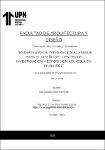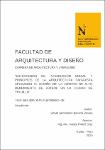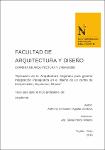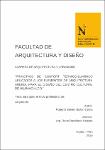Mostrar el registro sencillo del ítem
Estrategias de integración al paisaje para el diseño del centro de investigación y exposición acuícola en Piura, 2021
| dc.contributor.advisor | Torres Loyola, Elmer Miky | |
| dc.contributor.author | Arce Valverde, Ana Ximena | |
| dc.date.accessioned | 2024-04-23T21:46:35Z | |
| dc.date.available | 2024-04-23T21:46:35Z | |
| dc.date.issued | 2023-10-07 | |
| dc.identifier.citation | Arce, A. X. (2023). Estrategias de integración al paisaje para el diseño del centro de investigación y exposición acuícola en Piura, 2021 [Tesis de licenciatura, Universidad Privada del Norte]. Repositorio de la Universidad Privada del Norte. https://hdl.handle.net/11537/36369 | es_PE |
| dc.identifier.other | 712 ARCE 2023 | es_PE |
| dc.identifier.uri | https://hdl.handle.net/11537/36369 | |
| dc.description.abstract | La presente investigación corresponde a las estrategias de integración al paisaje, que integra los criterios de composición formal, percepción visual y espacial con el entorno natural, logrando una armonía entre lo edificado y lo natural para determinar el diseño del Centro de Investigación y Exposición Acuícola en Piura. A través de la arquitectura paisajista se busca analizar, diseñar y manejar el entorno natural y antrópico, por lo que se pretende, mediante las estrategias de integración, generar nuevos espacios flexibles y habitables que inviten al usuario a recorrerlo generando una continuidad entre el equipamiento y su contexto natural y por ende mejore la calidad visual del lugar y la calidad de vida del usuario buscando la sostenibilidad. En el primer capítulo, se observa que los centros de acuicultura de Perú sufren grandes carencias de equipamiento, la falta de normativa o parámetros para su óptimo diseño, y la necesidad por promover esta actividad de manera sostenible para la conservación de los recursos y suministro a las generaciones futuras con alimentos de calidad superior y menor impacto medioambiental. En el segundo capítulo, se expone la variable independiente: Estrategias de integración al Paisaje, donde a través del análisis del entorno natural, se desarrolla una serie de lineamientos de diseño que permitirán lograr espacios flexibles y habitables para el usuario, que lo impulse a la acción y generen una continuidad entre lo natural y edificado de manera sostenible. En el tercer capítulo, se presentan casos internacionales y nacionales, que serán de vital importancia para la presente investigación, pues nos dan mayor alcance sobre las estrategias de integración al paisaje. Además, se adjuntaron fichas de análisis para, en última instancia, obtener datos más precisos sobre los proyectos seleccionados. En el cuarto capítulo, se realiza la conclusión basada en el estudio de casos referente a los indicadores de la variable, se sintetiza el análisis de los casos elegidos, para finalmente elaborar los lineamientos de diseño para el Centro de Investigación y Exposición Acuícola en Piura 2021. En capítulo cinco, se muestra el dimensionamiento y envergadura del presente proyecto, en donde a través de referencias estadísticas calculadas e información de población referente, podemos obtener el radio de influencia y dimensionamiento del proyecto. Tras estos resultados, se realiza la programación arquitectónica, datos del terreno elegido y finalmente se desarrolla el diseño arquitectónico con la conceptualización y aplicación de las variables. | es_PE |
| dc.description.abstract | This research corresponds to the strategies of landscape integration, which integrates the criteria of formal composition, visual and spatial perception with the natural environment, achieving harmony between the built and the natural to determine the design of the Aquaculture Research and Exhibition Center in Piura. Through landscape architecture, the aim is to analyze, design and manage the natural and anthropic environment, so it is intended, through integration strategies, to generate new flexible and livable spaces that invite the user to walk through them, generating a continuity between the equipment and its natural context, thus improving the visual quality of the place and the quality of life of the user, seeking sustainability. In the first chapter, it is observed that aquaculture centers in Peru suffer from a great lack of equipment, the lack of regulations or parameters for their optimal design, and the need to promote this activity in a sustainable manner for the conservation of resources and supplying future generations with food of superior quality and less environmental impact. In the second chapter, the independent variable is presented: Landscape Integration Strategies, where through the analysis of the natural environment, a series of design guidelines are developed to achieve flexible and habitable spaces for the user, which encourage action and generate a continuity between the natural and the built in a sustainable manner. In the third chapter, international and national cases are presented, which will be of vital importance for the present research, since they give us more scope on the strategies of integration to the landscape. In addition, analysis sheets were attached to ultimately obtain more precise data on the selected projects. In the fourth chapter, the conclusion is made based on the case study regarding the indicators of the variable, the analysis of the chosen cases is synthesized, to finally elaborate the design guidelines for the Aquaculture Research and Exhibition Center in Piura 2021. In chapter five, we show the dimensioning and scope of this project, where through calculated statistical references and population information, we can obtain the radius of influence and dimensioning of the project. After these results, the architectural programming is carried out, data of the chosen land and finally the architectural design is developed with the conceptualization and application of the variables. | es_PE |
| dc.description.uri | Tesis | es_PE |
| dc.format | application/pdf | es_PE |
| dc.format | application/msword | es_PE |
| dc.language.iso | spa | es_PE |
| dc.publisher | Universidad Privada del Norte | es_PE |
| dc.rights | info:eu-repo/semantics/openAccess | es_PE |
| dc.rights.uri | https://creativecommons.org/licenses/by-nc-sa/3.0/us/ | * |
| dc.source | Universidad Privada del Norte | es_PE |
| dc.source | Repositorio Institucional - UPN | es_PE |
| dc.subject | Arquitectura del paisaje | es_PE |
| dc.subject | Diseño arquitectónico | es_PE |
| dc.subject | Arquitectura -- Composición | es_PE |
| dc.subject | Espacio en arquitectura | es_PE |
| dc.subject | Proyectos arquitectónicos | es_PE |
| dc.title | Estrategias de integración al paisaje para el diseño del centro de investigación y exposición acuícola en Piura, 2021 | es_PE |
| dc.type | info:eu-repo/semantics/bachelorThesis | es_PE |
| thesis.degree.grantor | Universidad Privada del Norte. Facultad de Arquitectura y Diseño | es_PE |
| thesis.degree.level | Título Profesional | es_PE |
| thesis.degree.discipline | Arquitectura y Urbanismo | es_PE |
| thesis.degree.name | Arquitecto | es_PE |
| dc.publisher.country | PE | es_PE |
| dc.subject.ocde | https://purl.org/pe-repo/ocde/ford#6.04.08 | es_PE |
| thesis.degree.program | Pregrado | es_PE |
| dc.description.sede | Trujillo El Molino | es_PE |
| renati.advisor.dni | 45436181 | |
| renati.advisor.orcid | https://orcid.org/0000-0001-8309-0547 | es_PE |
| renati.author.dni | 47460674 | |
| renati.discipline | 731156 | es_PE |
| renati.juror | Pretell Diaz, Nancy | |
| renati.juror | Marcial Guarderas, Tadeo Wilfredo | |
| renati.juror | Bocanegra Zecevic, Elena Mariel | |
| renati.level | http://purl.org/pe-repo/renati/level#tituloProfesional | es_PE |
| renati.type | http://purl.org/pe-repo/renati/type#tesis | es_PE |
| dc.relation.conformsto | 12% | es_PE |
Ficheros en el ítem
Este ítem aparece en la(s) siguiente(s) colección(ones)
-
Tesis [311]










